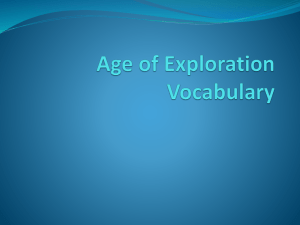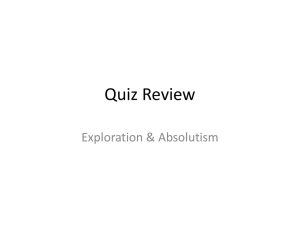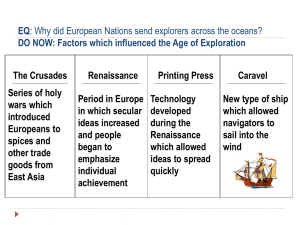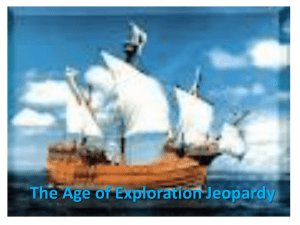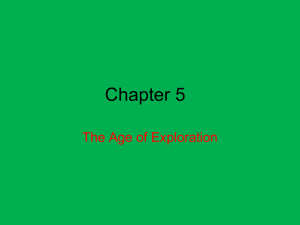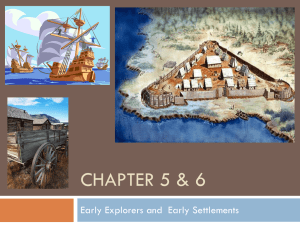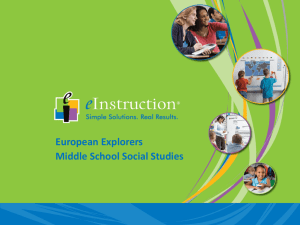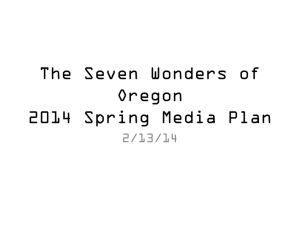File - Teaching Portfolio: Maggie Bradford
advertisement
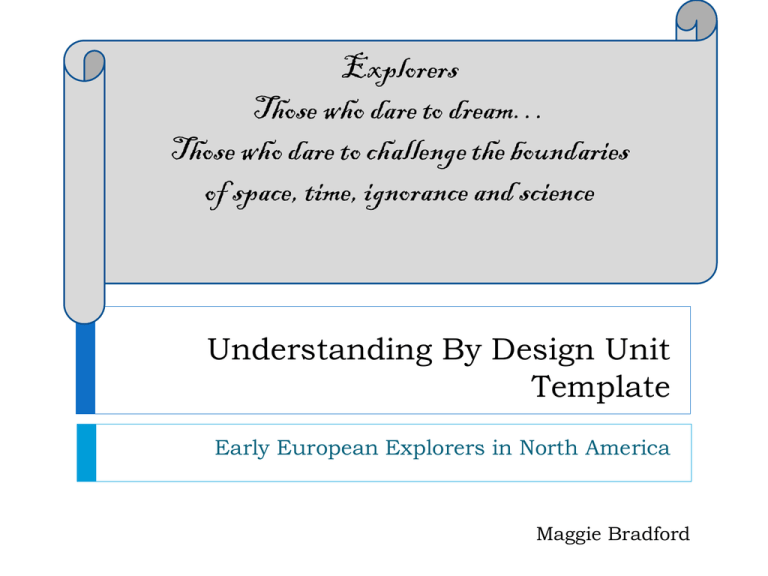
Explorers Explorers Thosewho whodare daretotodream… dream… Those Those daretotochallenge challenge the the boundaries Those whowho dare boundaries of space, time, ignorance and science Understanding By Design Unit Template Early European Explorers in North America Maggie Bradford Unit Overview In the Early European Explorer unit, students will learn about the world around them by exploring the many ways in which exploration and discovery influence history and the lives of people. The study of geography will continue to be woven into the unit, as students create and interpret maps and globes. The Explorer unit will spiral back to our study of Native Americans and students will incorporate previously learned concepts into new ideas about the explorers and their impacts on the Native American people. GPS Standard SS4H2 The student will describe European exploration in North America. a. Describe the reasons for, obstacles to, and accomplishments of the Spanish, French, and English explorations of John Cabot, Vasco Núñez de Balboa, Juan Ponce de León, Christopher Columbus, Henry Hudson, and Jacques Cartier. (Trinity School modifications: Sir Francis Drake, Hernando de Soto, Leif Erikson) b. Describe examples of cooperation and conflict between Europeans and Native Americans. Stage One: Desired Results Enduring Understandings •The exploration and discovery of new lands shapes our world and the lives of people in it •The introduction of new people and cultures can oftentimes impact existing societies in both harmful and beneficial ways •Geography influences history and the lives of people Essential Questions •What is exploration? •Why do people leave the safety and security of their families, homes, and jobs to investigate new places? •In what ways can different cultures help or harm each other? •How did geography influence the routes and final destinations of the explorers? Knowledge Students will know…. •Three main reasons why the explorers left their countries (spice, wealth, curiosity) •Multiple ways in which the arrival of the explorers changed the lives of the Native Americans (disease, Trail of Tears, change of society and way of life) •Key European explorers of the 16th century and their respective routes taken •Christopher Columbus •Sir Francis Drake •Hernando de Soto •Juan Ponce de Leon •Leif Erikson •Various types of landforms and where they might be located on a map or globe •The cardinal directions, hemispheres, and the location of the equator Skills Students will be able to… •Compare and contrast the routes and influences of different early European explorers •Interpret maps, charts, and timelines •Discuss points of view (perspectives) of both the European explorers and the Native Americans •Use persuasion to help achieve a goal •Work collaboratively with classmates Transfer Goal(s) Students will be able to independently use their learning to… •Compare the lives of European explorers from the 16th century to those of modern day explorers. •Regard interactions between people and cultures with greater perspective and empathy. Stage Two: Assessment Evidence Performance Task: Persuasive Poster Enduring Understanding: The exploration and discovery of new lands shapes our world and the lives of people in it. Description of Task: Gear up! You will become one of the European explorers that we have studied thus far. It is necessary that you recruit sailors for your next exploration into the unknown world. Your task is to create a poster that will invite citizens to join the new exploration crew. You will produce an informative, colorful poster that will include motivations for joining an exploration, incentives, risks and future opportunities, and geographic features that might pose challenges to you and your crew on the expedition. Include maps of several of your past routes and discoveries as well as a map of your intended upcoming route -Critics abound! Be prepared to provide an oral presentation for those citizens who doubt the exploration of unknown lands. Discuss elements of your poster and why you chose to put them on it. State specific reasons why you believe people should join your crew. Remember to speak clearly and loud enough so that citizens will hear your full message. Adapted from: http://www.curriki.org/xwiki/bin/view/Coll_curriki/EarlyExplorers Directions: •Review with students multiple advertisements and their persuasive messages. Ask: What are some ways that companies and advertisements try to get you to do or buy something? (*Quick review of Power of Persuasion lesson). •Next, inform students that they will be taking character of one of the 5 key explorers we have studied. Discuss with students the idea that exploration crews in history were traditionally all men, but that your crews will be made up of both girls and boys. In order to recruit members for an upcoming expedition, you will need to create a persuasive poster inviting citizens to join your crew. •Divide students into groups of 3-4 (depending on which explorer they have recently researched) and allow students 15-20 minutes to brainstorm thoughts and ideas. •Students will have access to recently gathered research notes, as well as books, Encyclopedias and the internet. •As groups complete their finished posters, remind students that they will be presenting their finished product to the class and persuading the audience to join their crew. Allow students time to prepare an oral presentation of their poster. The oral presentation should include a discussion of the elements on the poster and why students chose to put them on it. Students should state specific reasons why they believe people should join their crew. •Students present informative, persuasive posters to their classmates. Performance Task Address Stage One? The performance task addresses the desired results of Stage One in several ways…. The creation of an informative, persuasive poster as well as an oral presentation that directly speak to the UNDERSTANDING that exploration and discovery help shape the world we live in. Students focus on two important ESSENTIAL QUESTIONS a)What is exploration? and b)Why do people leave the safety and security of their families, homes, and jobs to investigate new territories? Students list and defend several reasons why someone should join their expedition to a new, unknown land. Students will exhibit their KNOWLEDGE regarding famous explorers and the reasons why those explorers left their countries. On their posters, they will draw and label various routes taken by explorers, displaying map skills and the UNDERSTANDING that geography plays an essential role in exploration. Students show us what they can do when they demonstrate certain SKILLS: comparing and contrasting the explorers and their routes, preparing a persuasive oral presentation to recruit crew members, and drawing and interpreting maps with various routes. Performance Task Fair and Unbiased? Authentic assessment that evaluates student performance and growth using input from both formative and summative assessment measures. -The poster will be assessed using an analytic rubric that evaluates different criteria on various skill levels (task-specific) -The oral presentation will be assessed using a generic presentation rubric Students have the opportunity to express their learning in various ways: orally through presentation of poster, collaboratively with classmates, visually through illustrations and maps on posters, and linguistically through speaking, reading, and writing. Key European explorers studied represent multiple countries and cultures: England, Spain, Scandinavia, etc. Multiple class periods set aside for completion of task. Directions are clear and specific, allowing students to work independently. Performance Task: Magazine Article Enduring Understanding: The introduction of new people and cultures can sometimes impact existing societies in both positive as well as harmful ways Description of Task: You are a writer for Living History magazine. You are hoping to have your editor publish an article that you will write on European explorers and the impact that they had on North America and its native people. In order to successfully write this article, you must go back in time and interview both a European explorer and a Native American tribe member. Your challenge is to determine how the explorers felt about arriving in the new land, as well as how the Native Americans felt about the explorers’ arrival. Did the two groups of people share similar feelings? Different feelings? How do you know? In order to gather the most accurate material for your article, you and two classmates will need to act out the scenario between the explorer, the Native American tribe member and the interviewer. -A successful job will result in a magazine article that clearly represents the view points of both the European explorers and the Native American people. Be sure to include the list of interview questions as well as an illustration. Remember to write in complete sentences, include a good title, and proofread your article. Once the article is complete, you will need to fill out a proposal form stating why you believe your article should be published in Living History magazine. Next, you and your classmates will come together to create one proposal, advocating for the publication of all of the articles and therefore the exposure of the many varying perspectives. Directions: •With 4 to 5 students seated at each table, pass out various copies of magazines to each table. Magazines such as National Geographic and other information-based magazines are best-suited for the students and this task. •Allow students time to look over and explore several of the magazines at their tables. •Using the board, show students an example of a magazine article. Discuss the title, layout, illustrations and/or photographs and answer any questions that students might have regarding the performance task. •Next, sort students into groups of three (with an explorer, Native American tribe member, and interviewer in each group) by having students draw numbers (marked 1,2, or 3) from a hat. The 1= explorer, the 2=Native American tribe member, the 3=interviewer. •Allow an extended amount of time for groups to meet, discuss and practice their roles. All three members of the group will help the interviewer assemble at least 5 interview questions. Students will reference previous lessons (Trail of Tears, introduction of diseases, etc.) *Students will have continued access to books, the internet, and any materials that will aid in the success of their role-playing scene. (Continued) •Groups of students will then take turns role-playing, with their classmates as an audience. •Revisit the example magazine article. Students may now begin drafting their own magazine articles, placing themselves in the shoes of both the explorer and the Native American tribe member. •Students will write a three paragraph magazine article and include at least one illustration. A title must be included as well. •Before sending the article off to publishing, the student must check-in with the chief editor, the teacher. The teacher will go over the article with the students in order to check for any proofreading errors that need to be addressed. •Once the magazine article has been completed, each student will fill out a proposal ticket detailing why they believe their article should be published in Living History magazine. •Finally, all students will come together to create one proposal, advocating for the publication of all articles and, therefore, the exposure of the many, varying perspectives. Performance Task Addresses Stage One? The performance task addresses the desired results of Stage One in several ways…. Through role-playing and constructing an article that explores the perspectives of both the explorers and the Native American people, students live in the UNDERSTANDING that societies can be impacted in many different ways when new people and cultures are projected upon them. It is ESSENTIAL that the students QUESTION whether the arrival of the European explorers was beneficial or harmful to the Native Americans and how both the explorers and the Native Americans felt about the event before they can construct an article with the different viewpoints. Information learned in lessons (the Trail of Tears, the introduction of small pox and other European diseases, and the ways in which the Native Americans lives changed) will culminate in the students’ KNOWLEDGE about the two different perspectives. This will be evident in student responses during role-play as well in the writing and illustrations that they do for the magazine article. What SKILL! Students will work collaboratively to role-play and compare and contrast the perspectives of both the explorers and the Native Americans. Performance Task Fair and Unbiased? Authentic assessment that evaluates student performance and growth using input from both formative and summative assessment measures. -Students are assessed with content-specific standard in mind (SS4H2 b. Describe examples of cooperation and conflict between Europeans and Native Americans). Students will be assessed using a generic analytic writing rubric. Students have the opportunity to express their learning in various ways. Students incorporate reading and writing in the magazine article, using their own understanding of the material to construct a response. Unit Graphic Organizer Stage Three: Learning Plan Unit Lesson: Exploration to Mars Lesson description: Students kick off their study of the early European explorers by first wondering What is exploration? Why do people explore? In order to help students originally connect with the concept of exploration, we have them consider an expedition to Mars by creating a word web. Students will brainstorm: HOW would you get to Mars? WHY travel to Mars? WHAT benefits of travelling might exist? WHO would travel to Mars? WHEN would you travel to Mars? Students would also explore the risks, challenges, and dangers of leaving home to explore. After the expedition to Mars, the class will complete a KWL chart. •Incorporation of Essential Questions: -What is exploration? -Why do people leave the safety and security of their families, homes, and jobs to investigate new territories? Unit Lesson: Explorer Jigsaw Lesson description: Students will work in groups to learn about various aspects of the key European explorers’ lives. With questions guiding the students’ collaborative research, every student is held responsible for the coverage of important information regarding one of the unit explorers. Once the information is assembled, students return to their original group or table to help “teach” their classmates about their explorer. Using MapMaker Interactive (http://education.nationalgeographic.com/education/mapping/interactivemap/?ar_a=1), students can draw out the routes taken by their individual explorer. Incorporation of Essential Questions: -How did geography influence the routes and final destinations of the explorers? -Why do people leave the safety and security of their families, homes, and jobs to investigate new places? - Unit Lesson: Modern Day Explorers Lesson description: Students will use their knowledge about past explorers to question, What are explorers discovering today? The lesson begins with an image of an early European explorer up on the board. Students will be asked several questions: Who is this? What do you see in the picture? Where is this person? Next, students will see an image of a modern day explorer. Ask similar questions. Inform students that about 95% of the Earth’s ocean is unexplored. After students have been exposed to the images, begin a discussion about modern day explorers and how they might compare and contrast to explorers in the past. Divide students into groups of 2-3 and hand out an image and a brief biography of a modern day explorer to each group. Students work together to determine the WHO, WHERE, WHY, and WHEN from the material provided. Groups will post the 4Ws up on the board on a timeline. Once all the groups have shared, students will have the opportunity to journal about modern day explorers and where they would like to explore if given the opportunity. Incorporation of Essential Questions: -What is exploration? -Why do people leave the safety and security of their families, homes, and jobs to investigate new places? *The fact is, most of the ocean floor has never been seen by human eyes. *In fact, our current estimation is that 95% of Earth’s ocean is unexplored. “Everyone is an explorer. How could you possibly live your life looking at a door and not opening it?” -Robert Ballard
